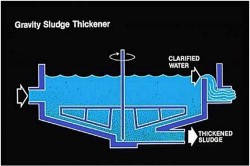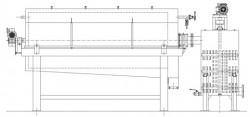Wastewater treatment plants commonly use thickening devices to increase the solids concentration at the end of a particular process step within the activated sludge process. Thickening of sludge increases its solids content and reduces the volume of free water thereby minimizing the unit load on downstream processes such as digestion and dewatering.
The most commonly used thickening processes include gravity thickening, dissolved air flotation, and rotary drum thickening. Centrifuge thickening is also becoming more common. The type of thickening selected is usually determined by the size of a wastewater plant, its physical constraints and the downstream process.
AES can offer gravity thickening, dissolved air flotation (DAF) thickening, centrifugal thickening, and rotary drum thickening depending upon the process application & space availability.
1. Gravity Thickening:
This process involves the concentration of thin sludges to more dense sludge in special circular tanks designed for this purpose. Its use is largely restricted to the watery excess sludge from the activated sludge process. It may also be used to concentrate sludge to primary tanks or a mixture of primary and excess activated sludge prior to high rate digestion.
The thickening tank is equipped with slowly moving vertical paddles built like a picket fence. Sludge is usually pumped continuously from the settling tank to the thickener which has a low overflow rate so that the excess water overflows and the sludge solids concentrate in the bottom. A blanket of sludge is maintained by controlled removal which may be continuous at a low rate. A sludge with a solids content of 8 -10 percent or more can be produced by this method. This means that with an original sludge of two percent, about four-fifths of the water has been removed, and one of the objectives in sludge treatment has been attained.
A gravity thickener is similar to a conventional sedimentation tank in design, but has a more steep floor slope. Tanks range from 6 – 20 m dia & side water depth (SWD) may vary from 3 – 4 m. Floor slope is varies from 1:4 to 1:6 depending upon the type of sludge, time required for thickening & storage volume to absorb peak solids load. The steeper slope reduces the raking problems by providing more gravity. A cross sectional view of the typical Gravity thickener is given in picture.
2. Dissolved Air Floatation:
The objective of flotation-thickening is to attach a minute air bubble to suspended solids and cause the solids to separate from the water in an upward direction. This is due to the fact that the solid particles have a specific gravity lower than water when the bubble is attached.
Dissolved air flotation depends on the formation of small diameter bubbles resulting from air released from solution after being pressurized to 40 to 60 psi. Since the solubility of air increases with pressure, substantial quantities of air can be dissolved. In current flotation practice, two general approaches to pressurization are used: (1) Air charging and pressurization of recycled clarified effluent or some other flow used for dilution, with subsequent addition to the feed sludge; and (2) Air charging and pressurization of the combined dilution liquid and feed sludge.
Air in excess of the decreased solubility, resulting from the release of the pressurized flow into a chamber at near atmospheric pressures, comes out of solution to form the minute air bubbles. Sludge solids are floated by the air bubbles that attach themselves to and are enmeshed in the floc particles. The degree of adhesion depends on surface properties of the solids. When released into the separation area of the thickening tank, the buoyed solids rise under hindered conditions analogous to those in gravity settling and can be called hindered separation or flotation. The upward moving particles form a sludge blanket on the surface of the flotation thickener.
The primary variables for flotation thickening are:
- Pressure
- recycle ratio
- feed solids concentration
- detention period
- air-to-solids ratio
- type and quality of sludge, (7) solids and hydraulic loading rates, and (8) use of chemical aids.
Similar to gravity sedimentation, the type and quality of sludge to be floated affects the unit performance. Flotation thickening is most applicable to activated sludges but higher float concentrations can be achieved by combining primary with activated sludge. Equal or greater concentrations may be achieved by combining sludges in gravity thickening units
3. Centrifugation:
Centrifugation has been demonstrated to be capable of thickening a variety of wastewater sludges. Centrifuges are a compact, simple, flexible, self-contained unit. They have the disadvantages of high capitals, maintenance and power costs and often a poor, solids-capture efficiency if chemicals are not used for bio sludges.
Centrifugal thickening is acceleration of sedimentation through the use of centrifugal force. Centrifuges are commonly used for thickening WAS (Waste Activated Sludge). Primary sludge is normally not fed to centrifuge as it may contain abrasive material. In addition of being effective in thickening, they have additional advantage of less space requirement, less odour potential & housekeeping requirement.
4. Rotary Drum Thickener:
The rotary drum thickener consists of the following components: stainless steel structural frame, sludge distribution system, filtering drum, filtering drum washing system, drum drive system, full set of covers, electric control panel (optional).
Water flows out through surface of the drum and sludge is transported by the spiral screw along the drum and finally out from the end of the drum. Sludge is led inside and through the drum over the flow edge. The spiral screw transports the sludge along the drum and finally out from the drum. The spiral screw mixes sludge slowly inside the drum so that water can come out from sludge very effectively. The horizontal position of the thickener can be lifted up to 10 degree. The outlet side is higher. The cleaning of the drum surface is carried out by pressure water-jet. There is nozzle pipe inside the basin of drum thickener for surface washing. Washing operates according to the adjustable timer program. The drum thickener is closed and compact construction, which makes the equipment easy to locate and avoid annoyance from odour and splashing.
Drum thickener selection is done according to following:
Type of sludge, inlet DS concentration, required outlet concentration, organic matters content, the material of construction which consists of the central shaft, spiral screw and the surface of the drum prevents the direct sludge flow through the drum from the begin to the end. The speed of the drum rotation can be adjusted by frequency converter.




